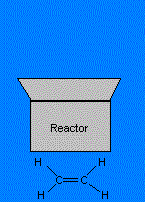


Converting
Ethylene to Polyethylene
Fluidized Bed
Perhaps the most important step of the
entire
process is
the conversion of purified ethylene gas to polyethylene. Today,
there are
a number of different processes that can be used to accomplish this
conversion, but a common method used in industry is to produce
polyethylene
by means of a fluidized reactor bed. A fluidized reactor bed
consists of
metallic catalyst particles that are 'fluidized' by the flow of
ethylene
gas, that is catalyst particles are floated in the ethylene fluid as
ethylene gas is pumped from the bottom of the reactor bed to the
top. Metallic catalysts are critical to the process, as
polyethylene cannot
be made without it. In fact, before the late 1970's an organic
catalyst was used to start the reaction. However,
because the organic peroxide catalyst is not as active as the metallic
catalyst, pressures in excess of 100 times the pressure required with
metallic catalysts were necessary.


X = Cl, Br, I,a = 0 or 1,b = 2 or 4, a+b = 3 or 4,and R is a carbon chain containing 1 to 14 carbons.
ReactorBefore ethylene is sent to the reactor, it must first be pressurized and heated. Pressures in the range of 100-300 PSI and a temperature of 100 degrees Celsius are necessary for the reaction to proceed at a reasonable rate. In addition, a catalyst stream is also pumped with the ethylene stream into the reactor as catalyst is consumed in the reactor. In effect, the catalyst is not actually consumed, it is simply included with the polyethylene product as polyethylene molecules remain stuck to the catalyst particle from which they were produced.
The conversion of ethylene is low for a single pass through the reactor and it is necessary to recycle the unreacted ethylene. Unreacted ethylene gas is removed off the top of the reactor, where it is seperated from the catalyst and low molecular weight polymer. After purification, ethylene gas is recycled back into the reactor. Polyethylene is gradually removed from the bottom of the reactor as soon as reasonable conversions have been achieved. Typically, ethylene remains in the reactor for an average of 3 to 5 hours. This results in a 97% conversion of ethylene.
|
Enormous amounts of heat is generated from the reaction . Heat is generally removed by cooling unreacted ethylene gas coming off the top of the reactor and recycling the cool gas back to the reactor. |
